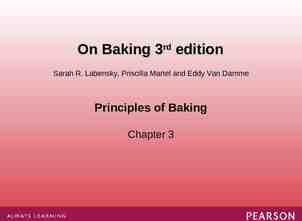Updated: January 25. 2005 Designing E/R Diagrams Christoph F.
22 Slides165.50 KB
Updated: January 25. 2005 Designing E/R Diagrams Christoph F. Eick: Designing E/R Diagrams
Conceptual Data Models Conceptual data models provide languages to describe conceptual schemas. Conceptual schemas are used to describe the classes of objects that occur in an application area, their properties, their relationships, and the constraints that hold with respect to those classes of objects. Center on “what kind of objects a database contains” and not on “how these objects are stored” ( Internal Schema) and not on “how these objects are represented / displayed to a person that accesses the database” ( External Schema). Christoph F. Eick: Designing E/R Diagrams
Conceptual Data Models --What are they good for? As a database design tool formalizing the information requirements of the end users As a documentation tool for databases (to help programmers, especially those that have to update the database) As a data model of a database management system (only very few experimental systems exist) As a tool to describe domain ontologies (terminology and concepts in a UoD) As a tool of system analysis Christoph F. Eick: Designing E/R Diagrams
Person name Is-insured Attribute (n,m) X Entity Type R Entities of type X participate at least n, at most m times in relationship R; * indicates . Relationship Type X Y Entity type X is a subtype of type Y Wedding occurred Weak Entity Type Identifying Relationship ssn Key Attribute from ------- Partial Key amount T1 T2 Type T1 and T2 are overlapping; an entity can belong to both T1 and T2; default is disjoint phone# Multi-valued Attribute to T1 Optional Attribute T2 Derived Attribute T3 T3 T2 T1 E/R Model Symbols for COSC 3480
(1,1) UGrad (0,25) (0,2) Student name (1,1)) Grad (0,*) employs (0,30) gre mentor salary ssn home took (0,*) Department (0,*) (0,*) Semester name Course grade semesterid title Cou# took-not-a-set: -2.5 Other Errors: -1.5 (or 3-4 if major) University Problem Final’03 COSC 3480
Exam1 Fall 2005 Problem Design a “good” entity-relationship diagram that describes the following objects in a university application: students, departments, sections taught in the present and future, and courses. Departments have a name that uniquely identifies the department. Students are identified by a unique social security number, zero, one or multiple e-mail addresses, and an optional gpa (new students do not have a gpa yet). Courses have a unique course number and a course title. Courses are offered in one or more sections at a particular time. Sections are identified by the time they are offered (e.g. 10:30-noon TUTH) and by the course they are associated with. Additionally sections are characterized by the class room the section is taught in. Only information concerning sections that are taught in the present or in the future is stored in the database. Students take a course in a particular semester and receive a grade for their performance. Sometimes students take the same course again in a different semester. There are no limits on how many courses a student can complete, and on how many students completed a particular course. Each student is associated with a least one department. Some students are graduate students that are additionally characterized by their most recent GREscore. Some graduate students work for a department and receive a salary for their services. Each department employs at most 75 graduate students; graduate students are not allowed to work for multiple departments. Christoph F. Eick: Designing E/R Diagrams
University Problem Exam1’05 ssn gre salary E-mail Student name Grad (0,1) (1,*) employs (0,75) (0.*) Department name gpa (0,*) assoc title took (0,*) Cou# (0,*) Semester Course grade (0,*) semesterid offered (1,1) took-not-a-set: -1.5 Section not weak: -2 Other Errors: -0.5--1 if minor -2—3 if major Section Time-offered classroom
Month name name city Contract set viol –3, Other: -2 Sal from (0,*) Team Home Visit (0,*) (0,*) ssn birthd (0,*) to (0,*) contr (25,*) (0,*) play (1,1) played-in. pos (18,*) score Game Date Game# Solution Problem6 Exam0 Spring 2003 Christoph F. Eick: Designing E/R Diagrams name Player pos
Sal name city NFL E/R Problem Team empl. Manager (1,3) (24,99) Home Visit (0,*) (0,*) contr (0,1) Player (0,*) weight Sal play played-in. score (1,1) min (22,*) Scoring: 1. Play relationship a Set: 3 2. Person/Player/Manager: 3 Game 3. Weak Game Entity: 3 4. Played-in: 2 5. Can Only Play once on a day: 1 6. Contract: 3 7. Salary, score, min attribute: 3 Christoph F. Eick: Designing E/R Diagrams ssn name (0,4) Date Person birthd height pos
Identifying Keys and Relationships for Entity Types Each entity type that is not subtype of another entity type needs: Case1: Normal Entity Type (single rectangle) 1. A single attribute (straight line) or 2. A set of attributes or Case2: Weak Entity Type (double rectangle) 1. A set of relationships (double diamond) or 2. A set of relationships or a single attribute (dotted line) or 3. A set of relationships and a set of attributes (dotted line) that uniquely identifies the instances of the entity type Remark: min-max cardinalities for weak entity types for their participation in identifying relationships have to be (1,1)!! Christoph F. Eick: Designing E/R Diagrams 1
(0,*) occurred husband Male wife (0,*) ssn name Person Female (1,1) Wedding (0,*) Is-insured (0,*) location amount to Company name from E/R Diagram for Multi-Weddings
Valid E/R Diagrams An E/R diagram is valid if and only if: It is syntactically correct (e.g. specifies all key constraints, ) It specifies the entity types, relationship types, attribute types, and subtype relationships necessary to satisfy all information requirements. It does not specify any invalid constraints. Christoph F. Eick: Designing E/R Diagrams 1
Priorities when Choosing Between Valid E/R Diagrams 1. 2. 3. 4. Express all constraints (you can express!) Use and do not change terminology and class structure of the application domain Keep it simple (avoid defining entity types that do not serve any purpose) Avoid redundancy (but derived attributes are okay)! Christoph F. Eick: Designing E/R Diagrams 1
A Quite Bad E/R Diagrams gpa Name department (0,*) gender worksfor Person wife ssn salary (0,*) husband (0,*) (0,*) (0,*) is-marriedto time takes (0,*) Section S# Course Christoph F. Eick: Designing E/R Diagrams Company C# 1
Example: Too many Entity Types / Don’t use Foreign Keys Example: Persons as well as animals can be insured P# Name (0,*) name isinsured Person ssn (0,*) Company (0,*) Boss-ssn Bad E/R Diagram! Animal A# Christoph F. Eick: Designing E/R Diagrams 1
E/R Diagram Design – Typical Errors 1. 2. 3. 4. 5. 6. 7. 8. 9. 10. 11. 12. Missing Constraints Unexpressed Constraints due to bad design Every entity type needs a key Attribute associated with the wrong entity type (relationship type) Relationships are sets! No partial participation in relationships! Missing existence dependencies (use subclasses) Invalid constraints Using Subtypes for n:1 relationships; using relationships when subtypes should be used. When defining relationships: Too general entity types for participating entities Too many entity types Using foreign keys instead of relationships Christoph F. Eick: Designing E/R Diagrams 1
Other Issues in E/R Design 1. 2. No relationships of relationships --- solution: create an entity type that represent instances of the relationship (or use aggregation as discussed in the textbook) value or entity type --- solution: choose entity type if it helps expressing constraints; otherwise, use value-type. Christoph F. Eick: Designing E/R Diagrams 1
University E/R Design Problem Design a “good” entity-relationship diagram that describes the following objects in an university application: students, instructors, professors, and courses. Students are subdivided into graduate and undergraduate students. Students take a course in a particular semester and receive a grade for their performance. Sometimes students take the same course again in a different semester. There are no limits on how many courses a student can take, and on how many students completed a particular course. Each graduate student has exactly one advisor, who must be a professor, whereas each professor is allowed to be the advisor of at most 20 students. Courses have a unique course number and a course title. Students and professors have a name and a unique ssn; students additionally have a gpa; moreover, graduate students have a GRE-score, and undergraduate students have a single or multiple majors. Professors can be students and take courses, but graduate students cannot be undergraduate students. Indicate the cardinalities for each relationship type; assign roles (role names) to each relationship if there are ambiguities! Use sub-types, if helpful to express constraints! Christoph F. Eick: Designing E/R Diagrams 1
gre major Grad Ugrad (0,1) advises grade (0,*) Semester (0,20) Professor ssn Student Person (0,*) took name gpa (0,*) Course title Cou# semesterid Enrolls-not-a-set: -4 Student must be ugrad or grad: -1 Other Errors: -2 (or –3 if quite major) University Problem (slightly different from Exam0’03)
number Cred-Card company (0,*) Problem 1 Exam1 Fall’03 (1,1) (1,1) C Transaction day made D Hotel from day Date Reservation rate Res# Ho# (1,*) (1,*) F G #avail (0,*) (0,*) (1,1) to G# address (1,1) E discount Gold Cl. (0,*) (1,50) Grading: Minor Error: -1 Medium Error: -2 Major Error: -3 or –4 0-4 points if too many errors Client B (0,1) ssn addr (0,300) A tr# phone# (0,*) Category room-type A: guaranteed; B: has transaction; C: for hotel; D: consists of; E: for category; F avail-rooms; G total-rooms; modified on Feb. 3, 2004 #total
ssn Aggregation Used when we have to model a relationship involving (entity sets and) a relationship set. Aggregation allows us to treat a relationship set as an entity set for purposes of participation in (other) relationships. name lot Employees Monitors since started on pid pbudget Projects until did Sponsors dname budget Departments Aggregation vs. ternary relationship: Monitors is a distinct relationship, with a descriptive attribute. Also, can say that each sponsorship is monitored by at most one employee. Christoph F. Eick: Designing E/R Diagrams 2
NFL E/R Design --Ungraded Homework --- due: Th., Jan. 27,2005 Design an Entity-Relationship Diagram that models the following objects and relationships in the world of football (NFL): teams, players, games, managers and contracts. Each (NFL-) team has a unique team name, and a city it plays in. Each person being part of the NFL-world has a unique ssn and a name. Additionally, for players their weight, height, position and birth dates are of importance. Players have a contract with at most one team and receive a salary for their services, and teams have at least 24 and at most 99 players under contract. Each team has one to three managers; managers can work for at most 4 teams and receive a salary for each of their employments. Players cannot be managers. A game involves a home-team and visiting-team; additionally, the day of the game, and the score of the game are of importance; teams play each other several times in a season (not on the same day!). Moreover, for each game played we like to know which players participated in the game and how many minutes they played. Indicate the cardinalities for each relationship type; assign roles (role names) to each relationship if there are ambiguities! Use sub-types, if helpful to express constraints! Christoph F. Eick: Designing E/R Diagrams 2



























